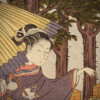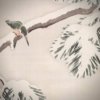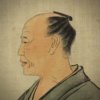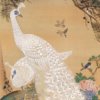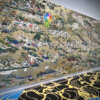Summary | Art History of Japan | Painting | No.2 Azuchi-Momoyama – Edo Period
Azuchi-Momoyama Period
The Azuchi-Momoyama period, which lasted from 1573 to 1603, was a period of less than fifty years, but it is one of the most important periods in the history of Japanese painting. This is because it was a period when there remained so many gorgeous works of art that anyone could easily understand their magnificence.
During the Warring States period, there were many feudal lords who had their own castles in their territories.
And in order to show off their power in the castle, they had painters create a lot of very gorgeous works. They competed with each other, and that’s why there are so many paintings left.
Ok, so let’s take a look at what kind of painters there were, in turn.
Well, the four most famous painters were Kanō Eitoku (狩野永徳), Hasegawa Tōhaku, Kaihō Yūshō, and Unkoku Tōgan.
These four painters are collectively known as the four great masters of the Momoyama art world.
However, in my personal opinion, Kanō Eitoku was by far the most powerful of the four great masters.
Kanō Eitoku was the grandson of Kanō Motonobu, who laid the foundations of the Kanō school.
As for Kanō Motonobu, I introduced him at the end of the Muromachi period. He was the one who established the mass production system of the Kanō school. Do you remember him? If you have forgotten, please kindly watch that part of the video again.
Kanō Eitoku’s most famous work is a Chinese Lions Painting folding screen. If you are a fan of Japanese art, you may have seen it at least once. It is gorgeous and powerful work. Another representative work is the Rakuchu-Rakugai-zu Byobu folding screen. It is said to be a gift from Oda Nobunaga to Uesugi Kenshin, depicting the scenery of Kyoto.
Next! Kanō Eitoku’s rival was Hasegawa Tōhaku.
This painter, Hasegawa Tōhaku, was originally born in Noto Province, now Ishikawa Prefecture, and he came to Kyoto and studied in the Kanō school at first, but he became more and more skilled from then on, and gradually became a threat to the Kanō school.
There were many conflicts between Hasegawa Tōhaku and the Kanō School over important projects, and at times the work of the Kanō School was threatened. Kanō Eitoku regarded such Hasegawa Tōhaku as dangerous.
Hasegawa Tōhaku’s masterpiece is the Pine Trees Folding Screen. Of course, he also painted glittering pictures, but this masterpiece is an ink painting. This ink painting is so high quality that it is considered to be the masterpiece of Japanese ink painting.
It is said that this work may have depicted the landscape of Noto, Hasegawa Tōhaku’s hometown. This is because his son died prematurely shortly before Hasegawa Tōhaku painted this work, and it is thought that his grief may have led him to think of his hometown.
The reason why this work is called a masterpiece of ink painting is that the work gives the impression of an air that is invisible to the eye.
Later, in the Meiji period, some artists tried to find a way to depict the air in their paintings, and they came up with the “Mōrōtai”, a drawing method with vague line drawing. However, this work was already able to express the air in this period, so it is regarded as a masterpiece.
Next is Kaihō Yūshō. This person has a very complicated career, he was a monk, a samurai, and a painter.
He is a famous painter of dragons, and the painting of dragons on the sliding doors of the Kenninji temple in Kyoto is very famous. I’ve been to see it and it’s really cool! I think it’s still open to the public sometimes, so if you have a chance to go there, please go and see it.
The last one is a painter called Unkoku Tōgan, who is sometimes called “the man who succeeded Sesshū Tōyō”.
“The man who succeeded Sesshū Tōyō” is such a cool catchphrase that we can hardly be afraid to say it, but he was more than capable of it.
He was asked by Mōri Terumoto, the lord of the Chōshū domain (present-day Yamaguchi prefecture), to revive Sesshū’s paintings, and was given the hermitage where Sesshū had lived, as well as some of Sesshū’s works. While Tōgan copied many of Sesshu’s works, he left behind a large number of works that made him famous in the era.
These four painters are considered to be the four great masters of the Momoyama period. However, as I mentioned earlier, Kanō Eitoku was by far the most talented.
But this Kanō Eitoku, he was so overwhelming that he received too many orders… He had a mass production system, but he drew too many pictures, and he died early among the four.
I think he was overworked… a bit too tired…
The death of Kanō Eitoku had a huge impact on the Kanō school.
Since Kanō Eitoku, the mainstay of the school, died, the influence of the Kanō school in the art world declined, and at the same time, Hasegawa Tōhaku became very powerful.
In fact, the Kanō school was robbed of its work by Hasegawa Tōhaku.
Moreover, around the time of Eitoku’s death, the struggle for political supremacy was very fierce.
The current government of the Toyotomi family is in a shaky state after the death of the charismatic Toyotomi Hideyoshi. Tokugawa Ieyasu was looking to take over from the weakened Toyotomi family, and the Imperial Court had maintained its influence since ancient times.
Which of the three major powers to follow was a matter of life and death for the Kanō school, which was supported by the authority of the time.
The Kanō school must have been in a state of panic.
I think they were all shouting something like this. “We have to take over from Kanō Eitoku, and Hasegawa Tōhaku is getting stronger, and which side should we follow, the Toyotomi, the Tokugawa, or the Imperial Court? Oh, My Goooooood!!!!”
The Kanō school thought about how they could survive in this turbulent time and came up with a strategy known as the “three sides strategy of the Kanō school”.
This was a strategy to have the family members divided and served to all three powerful families at that time, the Toyotomi family, the Tokugawa family, and the Imperial Court.
The idea was that whichever power survived, some members of the family would survive, and that they would be able to expand their power again and survive into the next era.
It was a desperate measure, but it is quite clever, isn’t it? I think it’s a great idea.
It shows the comprehensive strength of a family with a manual and mass production system.
And eventually, it was the Tokugawa family that survived. The court did not fail to survive, but it was the Tokugawa family that came to power in the next period.
The Kanō school, which gained overwhelming power in the system of the Edo shogunate of the Tokugawa family, is called “Edo Kanō”.
Unfortunately, the Kanō school, which served the Toyotomi family, was suspected by the Tokugawa family of being a remnant of the Toyotomi group, and although they managed not to be killed, they were not seen in the light of day and had to remain in Kyoto. They ended up working for the imperial court and the court nobles, but the painters of the Tosa School, who had already been in service to the court, were powerful there, so they didn’t get much public attention. This branch of the Kanō school is called Kyo Kanō.
It was a bit of a sad and cruel drama, but painters had to do it to survive.
After such a survival strategy, we move on to what happened to the Edo period.
Edo Period
The Edo period lasted from 1603 to 1868, about 250 years. This Edo period was very long. It was one of the longest periods in Japanese history, but there were no major wars, although many small ones did occur.
The long period of peace and tranquillity was a time when people’s minds were enriched and a variety of cultures flourished.
This is why there were so many different painters. Let’s look at them one by one.

